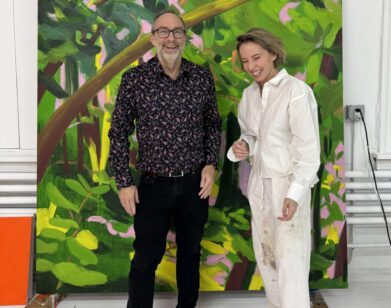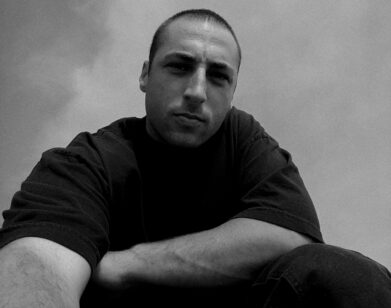Kori Newkirk
Born in the Bronx, Kori Newkirk first moved to California for graduate art school in 1995 and eventually settled in Los Angeles, where he began making work out of such obscure but provocative materials as hair extensions, pony beads, and pomade. Since then, the 38-year-old artist has continued to investigate cultural ideas and images of beauty, expanding his practice to include everything from neon lights to fiberglass sharks. A year ago, the Studio Museum in Harlem honored him with a 10-year retrospective of his work. Newkirk is now trying to put the past behind him and forge into some rather astounding and unexpected new directions.
CHRISTOPHER BOLLEN: Where’s your studio?
KORI NEWKIRK: Downtown L.A., for the moment. I’ve been in the same place for about 10 years, but I’m ready to leave. Downtown is becoming very gentrified-the entitlement isn’t good for me.
CB: Because prices are going up? Or is it about being in an atmosphere that’s bad for making work?
KN: The atmosphere. Gentrification is a complicated thing, you know? I’m more used to it in the traditional sense, where it’s a nice, long, slow thing—the New York style. In downtown L.A., money is making it happen very quickly. I prefer to be around people who have to work—to look out my window and see people who are, like, pushing carts and struggling.
CB: You recently had a show at LA.
KN: I wanted to deal with the idea of spectacle and celebrity, giving it some resonance with the political situation going on right now. I wanted to make the viewer complicit by having the whole thing mirrored—so we see ourselves in this.
CB: Do you feel like you fit into the L.A. art scene?
KN: L.A. is a very strange place. It’s been really good to me as an artist, but I’m still often times considered a New York artist, even by people who live here. There are collectors in this town who still, to this day, go, “What are you doing here? Did you just arrive?” They think I should be in New York.
I dont make work that is traditionally considered Los Angeles Art. The onlu Noir thing about my practice is me.Kori Newkirk
CB: Is that because you had a lot of success in New York?
KN: It might be. Or it might be because I don’t make work that is traditionally considered Los Angeles art. The only noir thing about my practice is me. [laughs] The dominant thrust for a while seemed to be noir and ironic. I just keep telling myself that I only live here, I’m not of here. That helps to keep me sane.
CB: So what will you work on next?
KN: I’m still going to tackle the subject of narcissism. [laughs] I’m going to make a giant toppled head out of Plexiglas and metal—like fake stained glass—for an upcoming solo show at The Project in New York.
CB: Whose head?
KN: Mine. [laughs] The head is going to look like it’s been pushed over, like when regimes change they knock down all of the old statues and chop off their heads. Whatever happens with the U.S. election, whichever way it goes, I think the work will still resonate.
Kori Newkirk
Born in the Bronx, Kori Newkirk first moved to California for graduate art school in 1995 and eventually settled in Los Angeles, where he began making work out of such obscure but provocative materials as hair extensions, pony beads, and pomade. Since then, the 38-year-old artist has continued to investigate cultural ideas and images of beauty, expanding his practice to include everything from neon lights to fiberglass sharks. A year ago, the Studio Museum in Harlem honored him with a 10-year retrospective of his work. Newkirk is now trying to put the past behind him and forge into some rather astounding and unexpected new directions.
CHRISTOPHER BOLLEN: Where’s your studio?
KORI NEWKIRK: Downtown L.A., for the moment. I’ve been in the same place for about 10 years, but I’m ready to leave. Downtown is becoming very gentrified-the entitlement isn’t good for me.
CB: Because prices are going up? Or is it about being in an atmosphere that’s bad for making work?
KN: The atmosphere. Gentrification is a complicated thing, you know? I’m more used to it in the traditional sense, where it’s a nice, long, slow thing—the New York style. In downtown L.A., money is making it happen very quickly. I prefer to be around people who have to work—to look out my window and see people who are, like, pushing carts and struggling.
CB: You recently had a show at LA.
KN: I wanted to deal with the idea of spectacle and celebrity, giving it some resonance with the political situation going on right now. I wanted to make the viewer complicit by having the whole thing mirrored—so we see ourselves in this.
CB: Do you feel like you fit into the L.A. art scene?
KN: L.A. is a very strange place. It’s been really good to me as an artist, but I’m still often times considered a New York artist, even by people who live here. There are collectors in this town who still, to this day, go, “What are you doing here? Did you just arrive?” They think I should be in New York.
I dont make work that is traditionally considered Los Angeles Art. The onlu Noir thing about my practice is me.Kori Newkirk
CB: Is that because you had a lot of success in New York?
KN: It might be. Or it might be because I don’t make work that is traditionally considered Los Angeles art. The only noir thing about my practice is me. [laughs] The dominant thrust for a while seemed to be noir and ironic. I just keep telling myself that I only live here, I’m not of here. That helps to keep me sane.
CB: So what will you work on next?
KN: I’m still going to tackle the subject of narcissism. [laughs] I’m going to make a giant toppled head out of Plexiglas and metal—like fake stained glass—for an upcoming solo show at The Project in New York.
CB: Whose head?
KN: Mine. [laughs] The head is going to look like it’s been pushed over, like when regimes change they knock down all of the old statues and chop off their heads. Whatever happens with the U.S. election, whichever way it goes, I think the work will still resonate.







